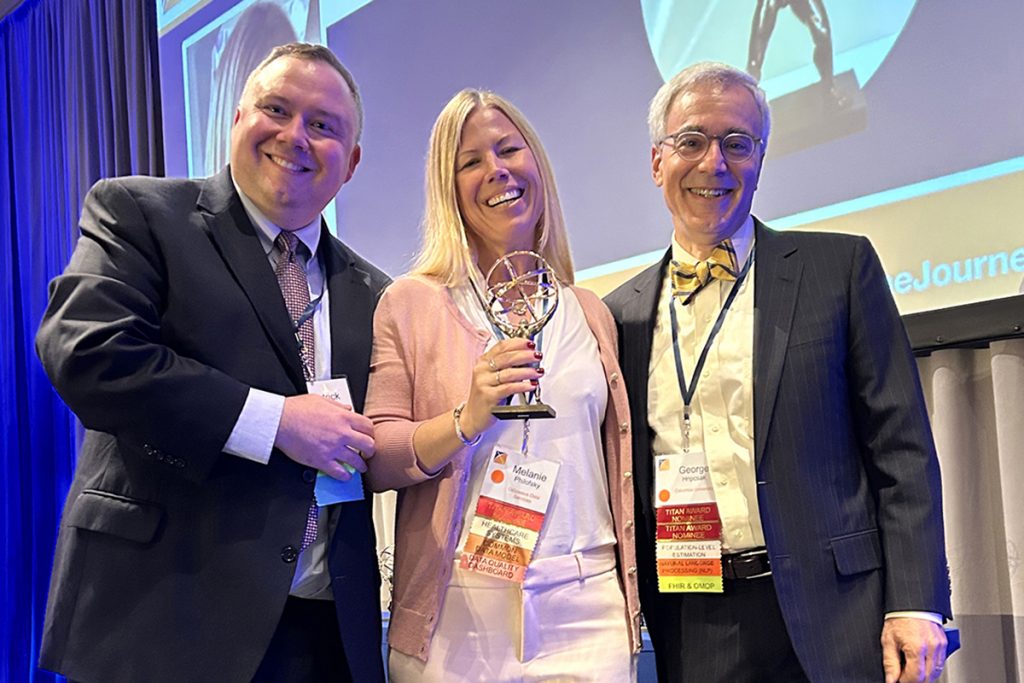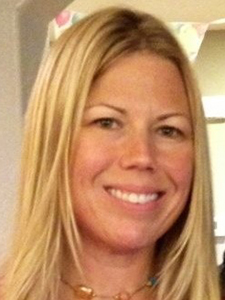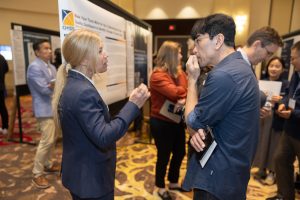- Who We Are
- Updates & News
- Standards
- Software Tools
- Network Studies
- Community Forums
- Education
- New To OHDSI?
- Community Calls
- Past Events
- 2024 India Symposium
- 2024 Europe Symposium
- 2024 Thailand Tutorial
- 2024 Japan Tutorial
- 2024 DevCon
- 2024 Phenotype Phebruary
- 2023 Global Symposium
- 2023 APAC Symposium
- 2023 Europe Symposium
- 2023 SOS Challenge
- 2023 DevCon
- 2023 Phenotype Phebruary
- 2022 Global Symposium
- 2021 Global Symposium
- 2020 Global Symposium
- ALL Past OHDSI Events
- Workgroups
- 2024 ‘Our Journey’ Annual Report
- Current OHDSI Events
- Support & Sponsorship
- CBER Best Seminars
- 2024 Global Symposium
- 2024 APAC Symposium
- Github
- YouTube
- Newsletters
Collaborator Spotlight: Melanie Philofsky
Melanie Philofsky is a Senior Business & Data Analyst with Odysseus Data Services, Inc. She is responsible for the harmonization of various healthcare data sources into the OMOP Common Data Model to support research endeavors. Her areas of expertise include clinical informatics, data analysis, data quality, ETL conversions, EHR data, the OMOP CDM and data modeling of new domains.
Prior to earning her MS in Healthcare Informatics, she was an ICU RN. She knows and understands the clinical workflow and UI of an EHR system to the backend where data is pulled for transformation to the OMOP CDM. She was the 2022 Titan Award honoree for Contributions in Data Standards.
In the latest edition of the Collaborator Spotlight, Melanie discusses

her career journey, her work with the Healthcare Systems and Themis workgroups, plans for the April Olympians Collab-a-thon, and more!
Can you discuss your career journey and why you transitioned from nursing to your work in health data?
As a bedside RN in the ICU, I frequently researched journal articles and practice guidelines to find evidence in support of nursing practice and theory. I hungered for more and better information and knowledge to provide the best, scientifically supported practices to holistically care for my patients and their families. It was always my intention to continue my education and earn an advanced degree. When I started researching career pathways for nurses, I came upon informatics. The more I learned about this field, the more I saw myself at the intersection of science and data to extract actionable information, knowledge, and wisdom to positively influence patient care. In the ICU I would care for 1 or 2 people at a time. With observational research, I am supporting hundred to millions of people in their health journey by producing evidence for them to make informed decisions.
How did you find OHDSI, and what inspired you to become a leader in the community?
I give credit to Dr. Michael Kahn for introducing me to the OHDSI community during my final semester of graduate school at the University of Colorado. OHDSI’s mission, vision and values align with my views and desires to produce reliable, real-world evidence to inform decisions on their healthcare.
I didn’t set out to become a leader in the OHDSI community. “Pay it forward” is one of my favorite mottos and I enjoy sharing knowledge, mentoring, and teaching. OHDSI is such an open and welcoming community, it just came naturally to share what I have learned with others. When I first joined the OHDSI community, health systems were not well represented. Through many different initiatives promoting value and awareness around the world, more health systems have joined the journey. During the 2018 OHDSI global Symposium, I met many new collaborators with EHR data starting their conversions to the OMOP CDM. There was a clear need to support the health systems, so I started the EHR working group, now known as the Health Systems Interest Group (HSIG). And from there I continued to volunteer teaching classes, participating in the various OHDSI-a-thons, bringing like minds together, examining needs and seeking solutions. And all along the way, I listened, researched, and critically examined the ideas, requirements, and issues presented to me and the community. We are one very large community, spread throughout many different locations, disciplines, and backgrounds coming together for a shared mission.
 You lead the Healthcare Systems workgroup, whose mission is to support healthcare systems on their OHDSI journey. What are the biggest challenges for systems to map their data to OMOP, and how critical is community support in the process
You lead the Healthcare Systems workgroup, whose mission is to support healthcare systems on their OHDSI journey. What are the biggest challenges for systems to map their data to OMOP, and how critical is community support in the process
There are many challenges in mapping EHR data to the OMOP CDM, but a few come to mind as being the most complex and difficult to overcome.
- Electronic Health Record systems are built to run the business of providing healthcare to populations. This includes managing patient care, seeking reimbursement for services provided, and reporting required metrics. They are not designed for the secondary use of health data in research. These two very different designs lead to complex incongruencies between the two data models. Understanding and mitigating these differences can be a steep learning curve when your brain has been thinking in the billing and encounter-based data model of the EHR system.
- Customization of health record systems was fabulous until it hampered research. When the HITECH act was enacted and more health systems started adopting EHRs, I was onboard with the idea. As a RN in the ICU, reviewing a patient’s past medical history was very important. And having the health record in an easily searchable, electronic format made the search much easier. However, early EHR systems allowed a lot of customization at the health system, hospital, and department level which led to inconsistency of data storage and interoperability issues.
The OMOP CDM is a clean, concise, normalized, person-centered data model. Learning the data model and designing analytics are straight-forward. However, when your brain has been thinking in the billing and encounter-based data model of the EHR system, the learning curve to OMOP can be steep. Many underestimate the time and resources it takes to learn OMOP and think from the OHDSI point of view.
The OHDSI community can support health systems in their journey by sharing our knowledge and experiences with other collaborators. One artifact the Health Systems group will produce this year is a repository for community contributed, semantic mappings for uncoded and string text data. Once established, the repository will provide a common area for collaborators to upload and retrieve mappings between uncoded data and standard concepts thereby increasing the amount of data available for research. Our other main objective is to publish the methodology for OMOP CDM users to transition their semantic mappings from the old style of mapping storage to a storage method visible in Atlas. These contributions increase data standardization and transparency of the mapping process.
You recently brought back the Themis workgroup to help support the mission of standardizing data. Why was this the right time to revive this workgroup, and what do you view its role in the community?
The OHDSI community hosted a Themis working session during the 2022 global Symposium. While planning the activity, I realized there were more Themis issues to review than time allotted. And some of these issues were quite complex and required more time and varied input than we had available at the Symposium. So, it just made sense to revive Themis and make it a year-round working group.
The goal of Themis is to provide conventions on how source data should be standardized to the OMOP CDM to support the OHDSI community in the generation of evidence that promotes better health decisions and better care. When there is ambiguity on how data should be inserted into the CDM, Themis will examine the issue, create a convention, and document it.
 You were honored with a Titan Award in 2022 for your work around data standards. How special was that honor, and what are you most proud of about your work in the community?
You were honored with a Titan Award in 2022 for your work around data standards. How special was that honor, and what are you most proud of about your work in the community?
Receiving the Titan award for Data Standards at the 2022 global OHDSI Symposium was a HUGE honor. I love the OHDSI community and my role in it. And to be recognized by such an amazing group of people from around the world is validating. I keep my trophy on my desk!
You recently announced that April would be the month of CDM & Themis conventions. Can you give a couple hints about what people can expect in April, and how impactful you hope this effort can be?
During April Olympians, the month of CDM and Themis conventions, participants will perform miraculous feats of standardization! Using the FAIR principles for guidance, participants will create clear documentation, a robust, reusable process, and an easily searchable repository for the OHDSI community to use when OMOPing their data, utilizing their OMOP CDM, or examining their data quality. We have done the foundational work of gathering requirements, examining solutions, establishing the collab-a-thon methodology, and enlisting the best resources to ensure the work we do in April produces the best product possible. We have roles to suit everyone’s desires and any time a person wants to give to the effort will be impactful and enthusiastically received. Many hands make light work!
What are some of your hobbies, and what is one interesting thing that most community members might not know about you?
I love all outdoor activities. I spend my free time traveling, hiking, skiing, trail running, mountain biking, scuba diving and exploring this amazing world! I love exploring cities, towns and rural areas from beaches to high mountain ranges to deserts, swamps and everything in-between. A fun, unknown fact about me is I am a certified, Colorado Master Gardener!
